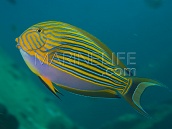Malindi (Kenya)

Océan Pacifique

Kendari (Indonésie)

Malindi (Kenya)

Acanthurus lineatus
Le patron de coloration d'Acanthurus lineatus varie peu selon les origines géographiques. Il est l'équivalent en océan Indo-Pacifique d'A. sohal de Mer Rouge.
- Maintenance :
- Medium
- Compatibilité aquarium récifal :
- Green
- Taille adulte moyenne :
- 25 / 9.8
- Taille minimale de l’aquarium :
- 500 to 1000 liters
- Relations intraspécifiques :
- Solitary
Lives in a shoal of many individuals - Relations interspécifiques, ne pas maintenir en présence de :
- Aggressive, beware with other surgeons and other passive fish.
- Dimorphisme sexuel :
- No
- Zone de vie dans l’aquarium :
- Full water
- Mise en garde :
- Slicing scalpels present at the base of the back fin
- Conseils de nos experts :
- Like most surgeons, the acclimatization of Acanthurus Lineatus is delicate at first glance, because this family is extremely sensitive to attacks of parasites type cryptocaryon ("white dots") and it is therefore necessary to avoid any stress in fish so as not to weaken it. Equally usually for this family, once acclimatized to its new environment, Acanthurus Lineatus will rather live its captivity serenely, rather sowing the disorder it will not suffer.
We therefore recommend maintaining it with comparable size species, and with a little fierce character. In priority, other surgeons of his aggressive access, he can also, in the end, take to influence other quite different families, and shake them up to death. We will beware of his enmities, especially with the fish introduced after him, to save them from his sometimes destructive wrath.
Even if he lives in a group, we will of course only take one specimen in aquarium.
The ideal volume of the aquarium will be at least 1,000 liters: it is a fairly large fish, who likes his ease, and is particularly lively and restless. He is an excellent swimmer who appreciates speed tips: the ideal for him will be a tank with the greatest possible length.
Note that the more he will feel cramped, the more aggressive he will be with all the other inhabitants of the bac.
This fish has the very sensitive integument, it is necessary to be careful with mycoses and the erosion of the fins and the side line. Watch out for the quality of the aquarium water, be sure to process bacterial attacks from their first signs and if you use active coal, use only a premium range specific to the marine aquariophilia (dust from The erosion of poor quality coals are recognized for their deleterious action, especially in the damage to the side line).
Remember that this fish is, like all the other fish-surgical fish, a herbivore, even if he also appreciates crustaceans and is good appetite in front of everything that can be offered to him in general. The surgeons are big eaters because, very dynamic, they spend a lot, and they also have a relatively thick "template" to maintain. This big appetite makes them little eyebrow on the nature of the food source available, although their digestive system in the long run.
To keep this fish healthy and guarantee its longevity, it is necessary to offer it plant foods every day, in the form of fresh or lyophilized algae, or granules for herbivorous fish. You can also offer fruits such as bananas, pear and vegetables such as poached spinach.
The amount of food available also conditions his "good humor": if he has to fight to eat his hunger, relationships with other aquarium fish will be felt.
His life expectancy can go up to forty years, if he is properly nourished and hosted in an adequate space with appropriate roommates. - Paramètre physico chimique de l’eau :
- Temperature 24-27 ° C, salinity 1.022-1.024, pH 8.0-8.4, KH 6-10, mg 1200-1400, CA 400-480, No3> 10, PO4> 0.05
- Régime alimentaire :
- Omnivore
- Origine géographique :
- Indian Ocean
Pacific Ocean
